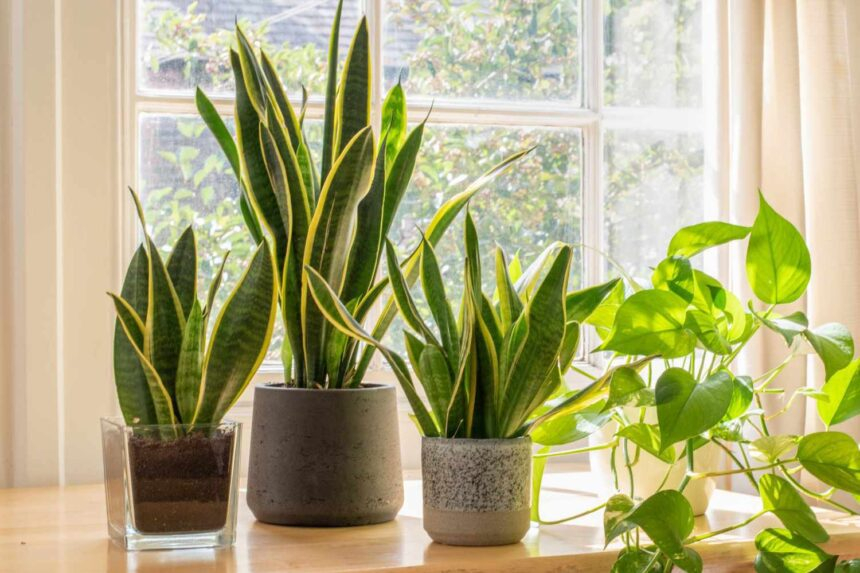There’s a solid reason why snake plants are so trendy at the moment. They are simple to maintain and care for as long as you know what to do, which makes them perfect for novice and busy plant parents. It’s quite challenging to kill a snake plant, even if you’ve had trouble maintaining other kinds of plants. Discover the best care advice for snake plants from our specialists by reading on to ensure the success of your prickly greens.
Plant snake plants in a location with indirect light.
You may be unsure about where to put your newly acquired snake plant after purchasing it from the nursery. Is your bright living room the right place for it? or your house office, which has a tree-lined shaded view? As head floral designer at Bouqs, Kaylyn Hewitt says you have a ton of choices.
“A cozy spot with indirect sunlight will work, although snake plants can tolerate low light as well,” the expert advises. This is the plant for that location that you know needs a plant but you’re not sure if it gets enough light. It can endure growing in moderate environments and adapts so effectively.
Ensure that the room is neither excessively hot nor dry.
Having said that, keep your plant away from rooms that face south or become hot easily. According to landscape contractor and Stihl representative Sara Bendrick, “hot, direct sun is not their favorite—they yellow and look sickly with too much direct sun.”
“The ideal environment would be one that is stable, doesn’t have too many drafts, and has temperatures ranging between 65 and 75 degrees Fahrenheit,” explains Paris Lalicata, The Sill’s plant specialist. Since they are tropical plants, snake plants can withstand typical room humidity levels, but higher humidity levels will not hinder their ability to develop more quickly.
Take Care Not to Overwater Your Snake Plant
Are you really busy? Do you take regular trips? Your snake plant is not really something to be concerned about. Snake plants are usually more vulnerable to overwatering than to underwatering, according to Hewitt. “In the warmer months, once a week is a good cadence; in the colder months, up to once every two weeks is appropriate.”
When it comes to watering, it’s imperative to practice less is more. “Soft-rot, a disease that causes oozing, water-soaked lesions on the foliage that can spread quickly, is susceptible to snake plants,” says Lalicata. “To ensure that the plant is robust enough to fend off potential diseases, keep the leaves dry and provide ample lighting.”
However, don’t panic if you do overwater it! We’re all human, and fixing this one is simple. Bendrick advises, “If you overwater your snake plant, raise the container so the bottom can drain out freely and let it air out for a short while before you resume your reduced watering schedule.”
Select a Planter with Adequate Drainage
This takes us to our next point: it’s critical to put your plant in a planter with a large enough drainage hole to ensure its success. “This plant does not want to sit in a bowl of supersaturated water for long periods of time,” Lalicata states. Water it sufficiently to make the soil feel like a wrung-out sponge and to the point where water drips out the bottom of the container.
After a Few Years, Repot Your Snake Plant
Is your snake plant expanding to the point where it’s spilling over the pot? This indicates that it’s probably time to repot your plant since it requires a new place. Remember that because their roots are shallow, this will likely take several years. “Use any regular, well-draining potting mix and increase the diameter of the container by one or two inches,” advises Lalicata.
Where should I place my snake plant?
Snake plants can be placed in a cozy spot with indirect sunlight. They can also tolerate low light, making them adaptable to various locations in your home.
What is the ideal environment for a snake plant?
The ideal environment for a snake plant is a stable room with temperatures ranging between 65 and 75 degrees Fahrenheit. The room should not be excessively hot or dry.
How often should I water my snake plant?
In the warmer months, watering once a week is sufficient. In the colder months, watering once every two weeks is appropriate. Snake plants are more vulnerable to overwatering than underwatering.
What should I do if I overwater my snake plant?
If you overwater your snake plant, raise the container so the bottom can drain out freely and let it air out for a short while before you resume your reduced watering schedule.
What type of planter is best for a snake plant?
A planter with a large enough drainage hole is best for a snake plant. This ensures that the plant does not sit in supersaturated water for long periods.
When should I repot my snake plant?

If your snake plant is expanding to the point where it’s spilling over the pot, it’s probably time to repot your plant. This will likely take several years as their roots are shallow.









